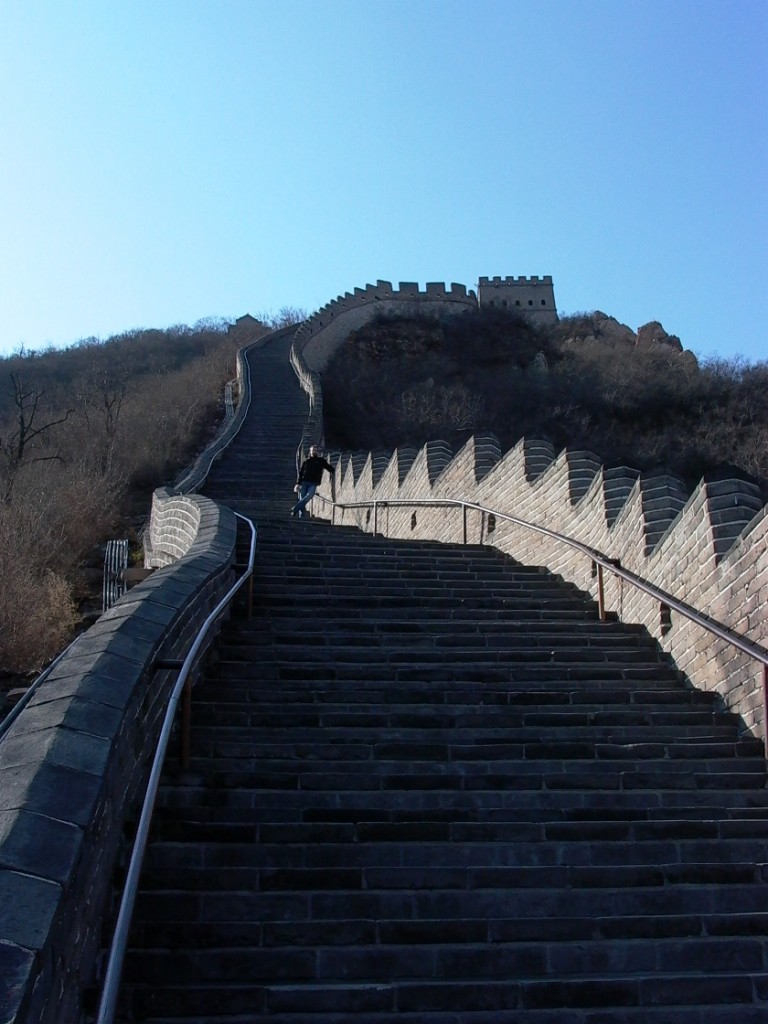Nov. 22 – Beijing
“You must see the wall to be a hero” goes a Chinese saying. You can’t be snobbish about seeing one of the wonders of the world. It’s something you simply have to do if you can. But you can pick the route less traveled to get there, and today that’s what Daniel and I did.
Not for us the plush, pricey tour buses going to the Great Wall at Badaling, the most tourist-frequented destination. Instead, we hopped on the public bus (30 cents) as it squeaked and bounced to its terminus at the Juyong Guan part of the Wall. We left at around 10am, safely past the commuter crush, and had seats for the 70-minute ride through the northwestern suburbs of Beijing. I’m sure there is a comprehensive land-use plan, but it was as if God was having fun playing Sim City with Beijing. A cement works and an immense coal depot beside a golf course; a locomotive factory close to a university with a prominent white cupola; a gated community with an ostentatious statue of a Roman charioteer next to a People’s Liberation Army barracks.
It was a good day for the Great Wall. Mid-week, off-season, no crowds. Best of all, though, was escaping the smog. After yesterday’s “very unhealthy” rating, Beijing’s air had actually worsened overnight due to the swarm of diesel-belching delivery trucks. So in the morning my eyes itched, I had a headache, and felt like my lungs were peanut-sized. Starting on the Wall’s steep steps changed all that. Home is where the heart rate is, and it felt good to move and to breathe relatively clean air. It wasn’t long before I got serious about passing everybody else ahead of me. Daniel in tow (he’s in shape and kept pace), we stomped past the Chinese, Indian, French and American tourists on the rampart. After about 20 minutes, 1km distance and 300m of vertical (yes, trail running friends, we checked on Google Earth), we reached the segment summit, snot dripping, sweat trickling, and happy. From our windswept vantage point we could see a long beige stone ribbon coiling down the valley and back up the other side. We descended with less bravado, but will doubtless have delayed onset muscle soreness tomorrow.
Taking a regional bus back towards Beijing, we stopped for a late lunch at a “village” (thousands of residents) named Yangfang. In a large, empty restaurant, we had the local specialty; a hotpot of boiling water into which we dropped thin, pink slices of mutton and Chinese mushrooms, turnips, and cabbage. Once cooked, these were dipped in a peanut sauce and flavoured with coriander. By the time we left the restaurant, the wind had picked up, swirling dust and dead leaves in our faces. What makes the place particularly interesting is that it is a Chinese muslim community. There was a whiff of coal smoke as we strolled past the 500-year old mosque and new-looking madrassa to our last, lonely bus stop. Everyone knows about the Great Wall. Not even Beijingers know about Yangfang.

